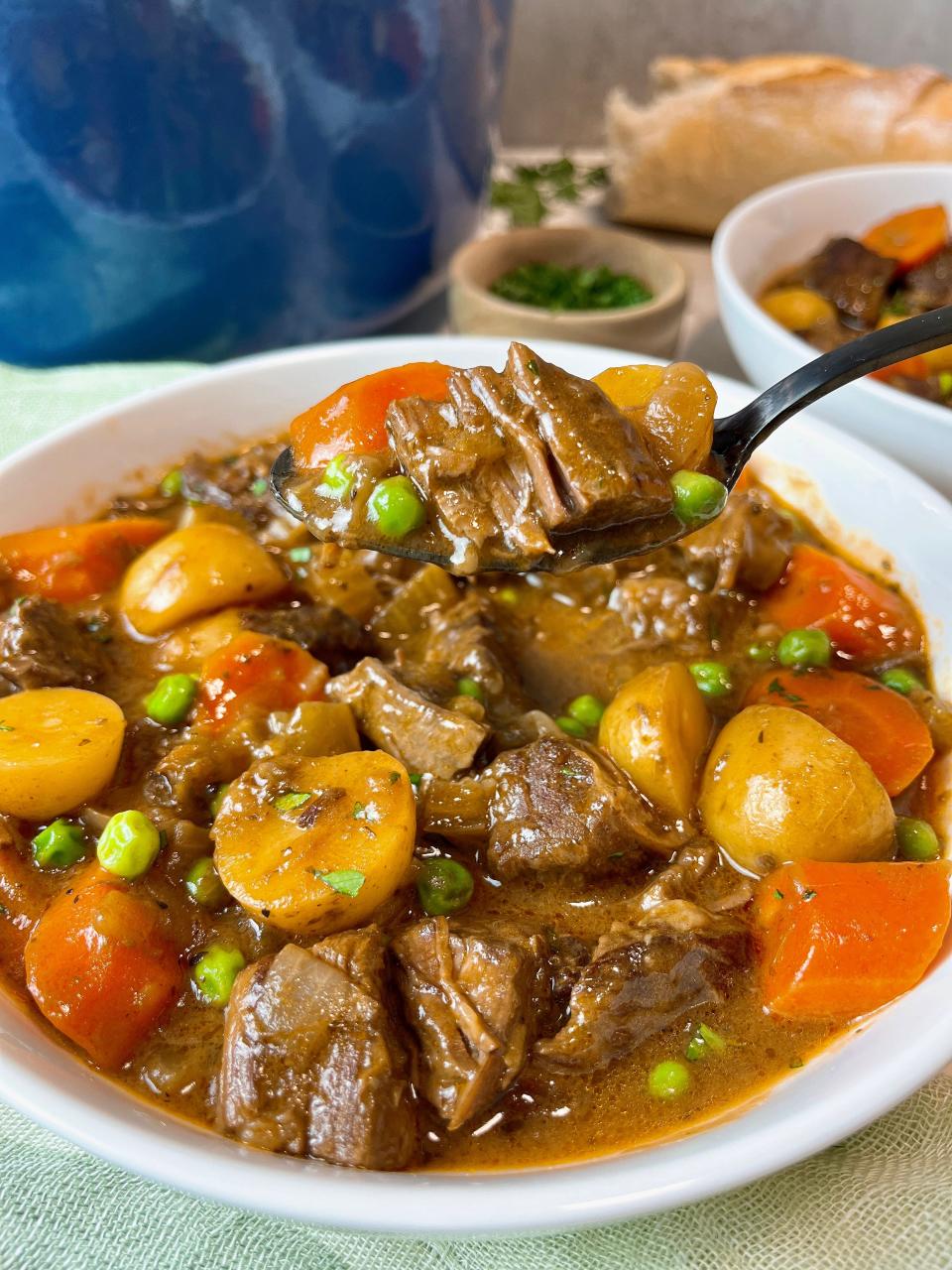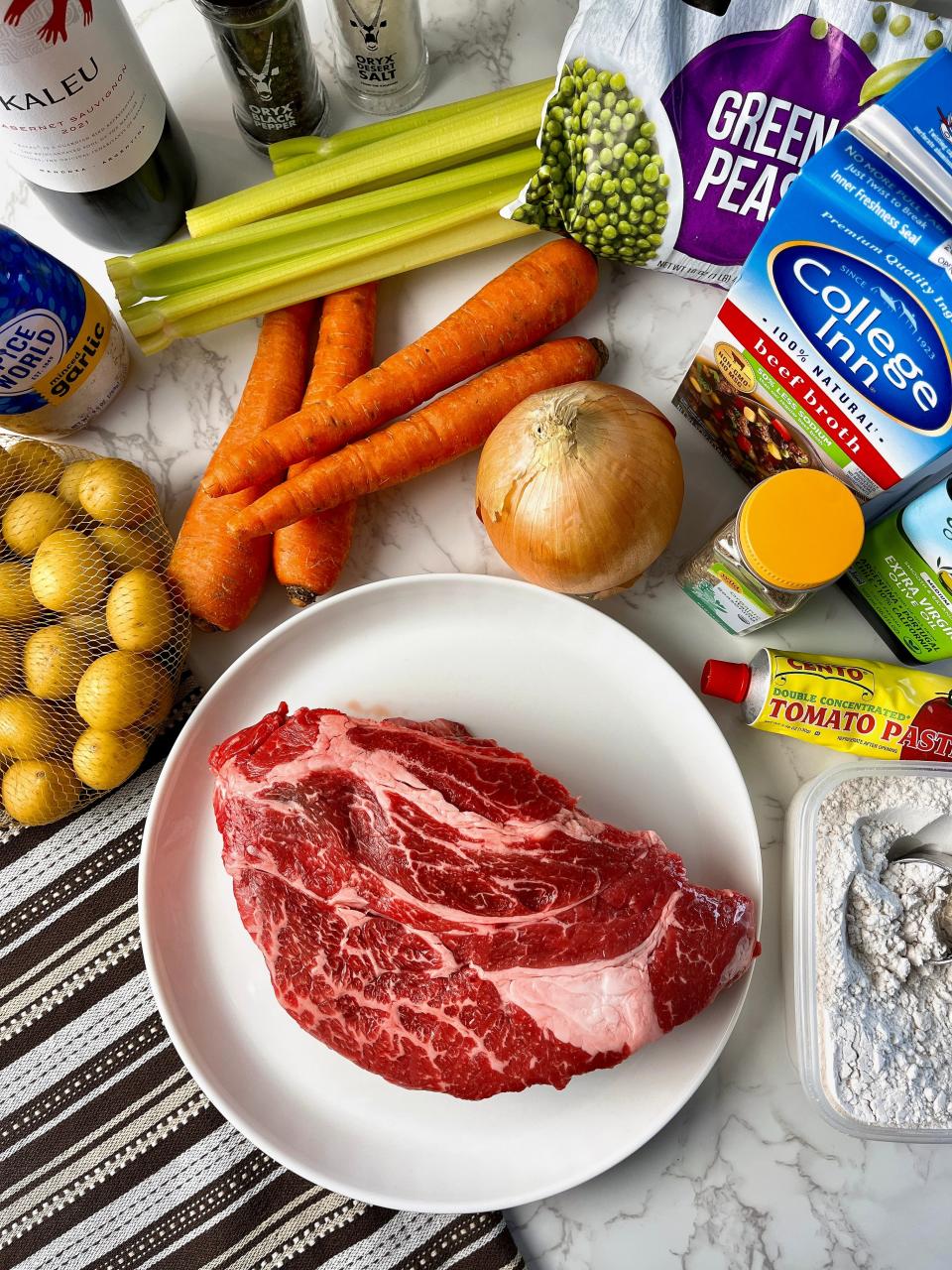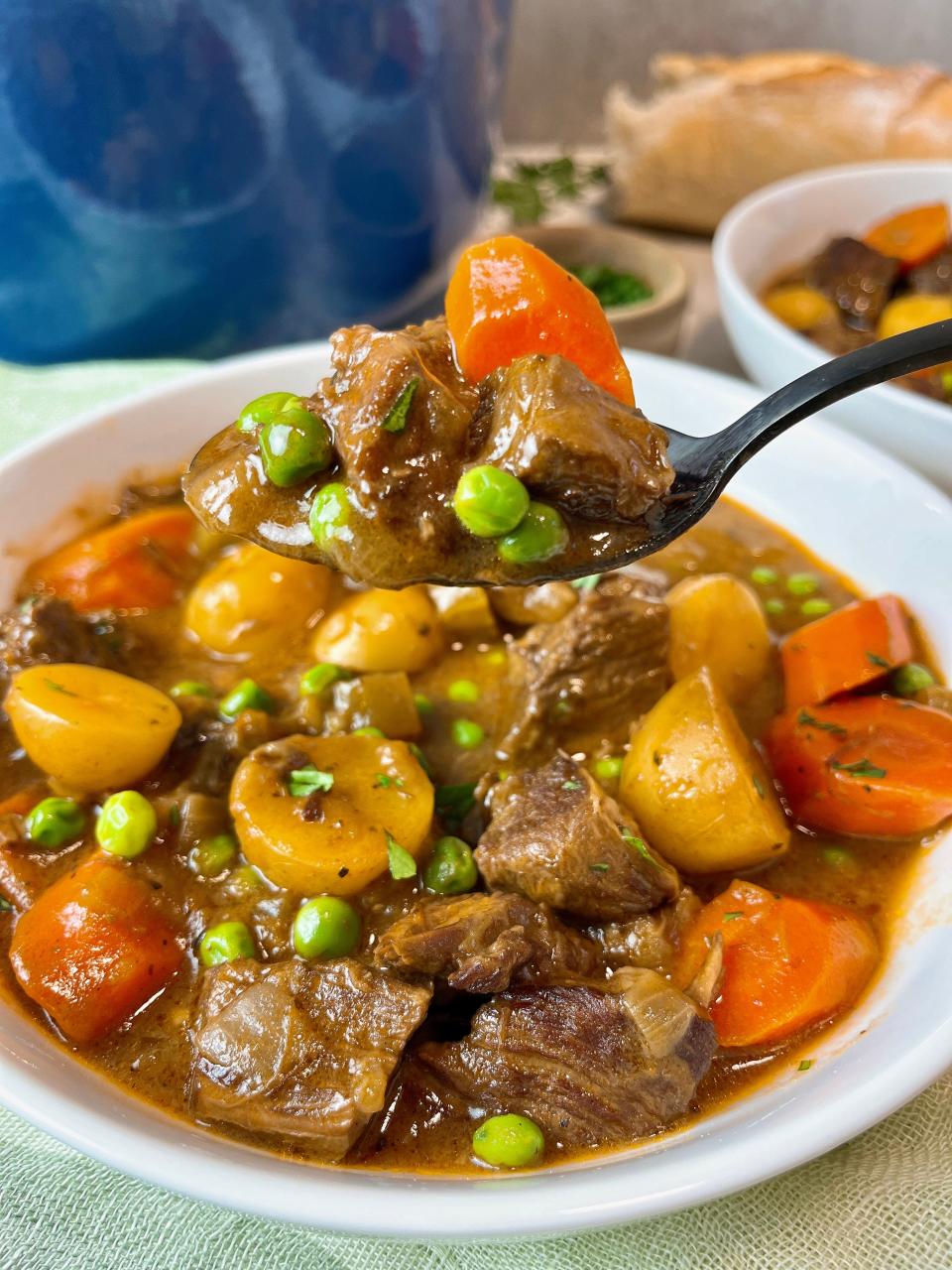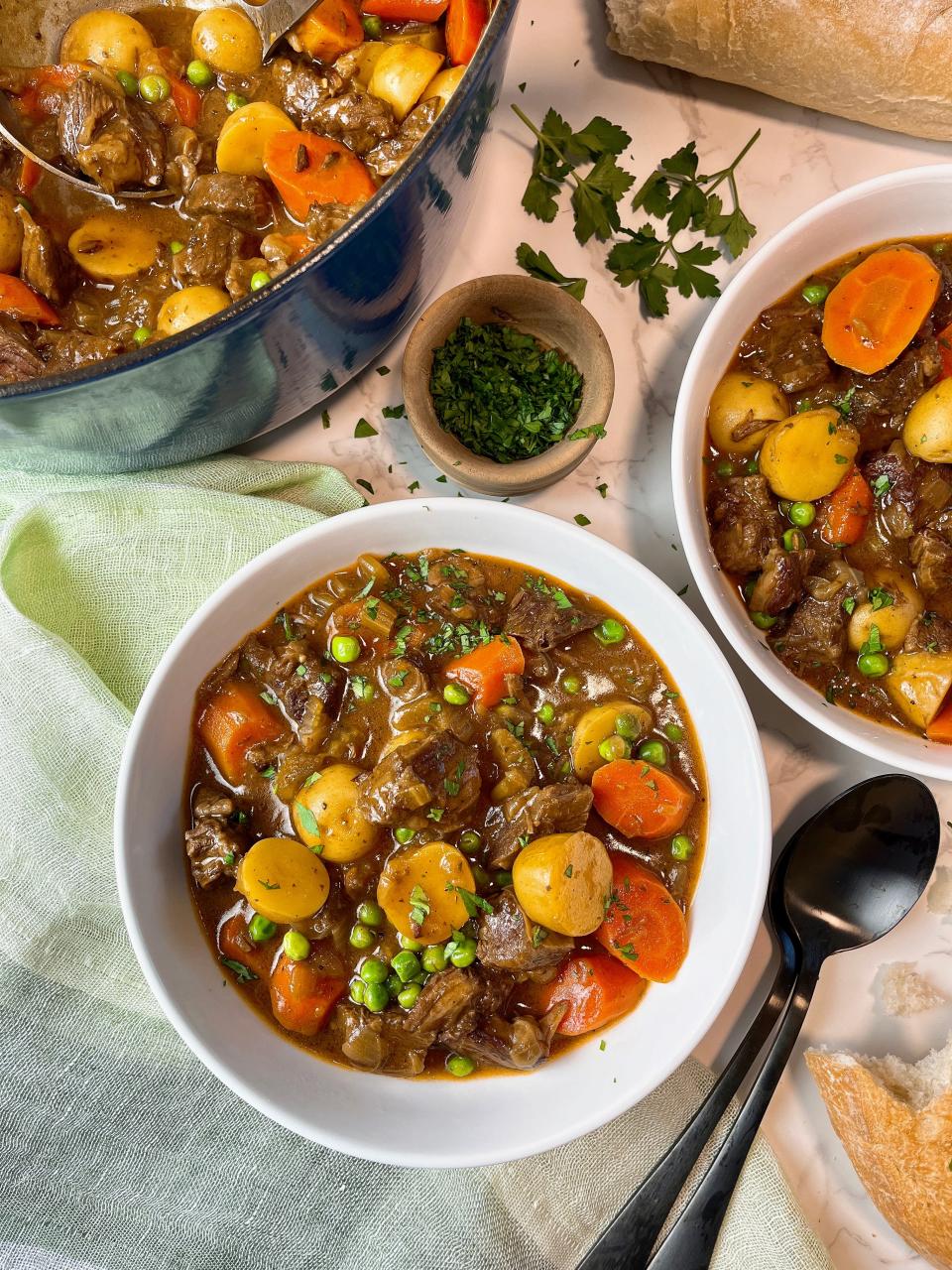Simple and comforting, this is the only beef stew recipe you'll ever need
Fork-tender beef, aromatic vegetables and an herb-scented, wine-infused broth make this the ultimate beef stew. Hearty bowls of buttery beef and warm vegetables can be enjoyed whether you’re swaddled in your comfy pants or bedecked in your finest attire and the beauty of this stew lies in the fact that it’s easy to make and the low, slow cooking time is a great excuse to cozy up in the house.
There's also no need to hunt down obscure ingredients or buy fancy cookware. Your sturdiest pot will do. You don’t even need a well-stocked spice rack. Which is why this is such a time-honored, one-pot winter meal.
However, because it's so simple, I have a few suggestions to ensure you get a great result every time.
Culinary fairy godmother Ina Garten wrote a cookbook for real life: 'We're all kind of exhausted'
What is stew meat?
Don't buy stew meat. Despite what the label says, stew meat is not typically good for stew. It’s often lean, which means it will never get tender, no matter how long you cook it. Instead, use well-marbled chuck roast with plenty of white fat streaks running throughout the cut.
That fat melts during cooking, tenderizing the meat and adding tremendous flavor to the stew. Fattier cuts also contain collagen-rich connective tissue, which melts into gelatin, which, in turn, thickens and enriches the stew while creating a satiny broth.
Why you should brown your beef before simmering
Don't skip the browning step. Browning the beef over medium-high heat caramelizes the exterior and gives the meat a deep, rich flavor. Plus, after searing, tender bits of beef can be found clinging to the bottom of the pan and those tasty morsels add tons of flavor to the wine-spiked broth.
Be sure not to crowd your pan when searing the beef. A crowded pan also creates a lot of juice, so your beef will steam instead of sear. As mentioned above, browning the beef is critical for creating a stew with depth of flavor. If you’re like me, you probably don’t have a pot big enough to sear two pounds of beef in a single layer. That means you need to work in batches to ensure that every cube of beef hits the bottom of the pan and caramelizes.

How long to cook beef stew
Don’t rush things. Beef stew requires time, and lots of it. You need more than three hours before you can feast. Thankfully most of the cooking time happens in the oven and doesn't require any attention at all.
The long cooking time gives the collagen-rich meat a chance to break down and tenderize and it allows the rest of the ingredients to evolve and develop great flavor.
You can’t cheat either — if you try to speed things along by boiling the meat instead of slow-braising in the oven, the meat’s muscle fibers will seize up and toughen.
Add quicker-cooking vegetables later, not in the beginning. In this recipe, the onion, celery and garlic hit the oven with the beef because these aromatic vegetables will lend their essence to the broth and enrich the stew. If you add the carrots and potatoes in the beginning, they will turn to mush after three hours in the oven.
Bottom line, give the beef a two hour head start, then add your veggies.
What wine is used for beef stew?
Use wine or not. But wine does add great flavor and complexity to the broth.
When choosing the wine, use any dry red variety, like Pinot Noir, Merlot or Cabernet Sauvignon. There’s no need for a pricy bottle, inexpensive, good-tasting vino is perfect. But make sure it's good enough to drink. You'll taste it.
If you’d rather not use wine, you can deglaze the pan with beef broth. To mimic the acidity wine adds to the broth, add about 1 tablespoon of red wine vinegar or balsamic vinegar to the broth you're using for deglazing.
Another classic: Make easy, herb roasted pork tenderloin
Can I make beef stew on the stovetop?

Don’t have an oven-friendly pot? No problem.
If you don’t have a Dutch oven or oven-safe pot with a lid, the stew can be cooked on the stovetop. Take note, this is not my first choice. When cooking on the stovetop, the liquid often reduces significantly. Check your stew every 30 minutes when cooking on the stove and add more broth if needed. The timing will be the same – 2 hours without the carrots and potatoes and then 1 hour with them. Use the low setting and make sure the stew is barely simmering, not boiling.
How to adjust seasonings to taste
When something cooks for three hours, it’s always a good idea to taste before serving. Salt and black pepper are the obvious first choice when adjusting the flavor, but there are other options as well.
If your stew seems flat or one note, add a splash of Worcestershire sauce, lemon juice or balsamic vinegar to elevate every element in the stew.
If your stew seems overly tangy, add a bit of honey, molasses or brown sugar to balance it out.
You can also adjust the amount of broth as desired. This stew is thick. After all, we’re not making soup. But, if you like your stew on the thinner side, add more broth before you fold in the peas. Be sure to wait to decide on whether to add broth until after the vegetables have finished cooking.
Can I make beef stew ahead of time?

Consider making this stew in advance. Beef stew is often better the next day, after ingredients have mingled all night. Let the stew come to room temperature and then refrigerate overnight or up to 3 days.
When ready to serve, reheat the stew on the stovetop over medium-low heat or in a 350 F oven until the stew is hot all the way through.
Bank extra stew in the freezer. Since you spent all afternoon waiting for stew, don’t waste any leftovers. Transfer the stew to an airtight container and freeze for up to 3 months.
Pro tip: For quick-thawing and single meals, store the stew in individual portions. Defrost the stew overnight in the refrigerator before reheating.
Did someone say cookoff? How to make classic beef chili (with or without beans)
What to make with beef stew
How should you serve your beef stew? With a ladle and a smile. Since beef stew is crammed with meat and vegetables, it’s essentially a complete meal.
I like to serve warm, crusty bread on the side to wipe the bowl clean. You can also serve the stew with crackers, biscuits or cornbread.
Weeknight pasta: This easy lasagna takes only 30-minutes and one pan

Recipe: Classic Beef Stew
Servings: 6
Ingredients:
2 pounds boneless beef chuck, cut into 1 ½-inch pieces and larger pieces of fat trimmed and discarded (don’t remove too much of the fat; it keeps the beef tender and moist)
Salt and freshly ground black pepper
4 tablespoons olive oil, divided
1 yellow onion, chopped
4 stalks celery, chopped
2-3 cloves garlic, minced, or 1 teaspoon pre-minced garlic
½ cup red wine or beef broth
¼ cup all-purpose flour
4 cups beef broth
3 tablespoons tomato paste
1 teaspoon Italian herb seasoning
1 pound small gold or white potatoes, cleaned and halved
4 carrots, cut on a bias into bite-size pieces
¾ cup frozen peas, kept frozen until ready to use
Chopped fresh parsley, for serving
Preparation:
Set an oven rack in the lower middle position and preheat the oven to 325 F.
Pat the cut, trimmed beef dry and season generously with salt and black pepper.
Heat 1 tablespoon of the olive oil in a large Dutch oven or ovenproof stock pot (with lid) over medium-high heat. To prevent crowding the pan, cook the beef in three batches.
Add one third of the beef cubes to the hot oil and cook, turning with tongs, until all sides are dark brown and well-seared. Transfer the browned beef to a large plate and repeat 2 more times, using 1 tablespoon of oil for each batch of beef.
Heat the remaining tablespoon of oil in the same pot over medium-high heat. Add the onion, celery and garlic and cook for 3 to 5 minutes or until soft.
Add the wine and bring to a simmer, scraping up any browned bits from the bottom of the pan. Simmer until the liquid is thick and almost completely reduced. Return the beef to the pot with any accumulated juices from the plate. Add the flour and stir to coat. Stir with a wooden spoon until the flour is dissolved.
Add the beef broth, tomato paste and Italian seasoning and bring to a boil. Cover the pot with a lid, transfer to the oven and braise for 2 hours.
Remove the pot from the oven and stir in the potatoes and carrots. Cover and return the pot to the oven for another hour or until the vegetables and meat are tender and the broth is thickened.
Remove pot from oven and stir in the peas. Set aside until peas are heated through.
Ladle the stew into bowls, top with parsley and serve.
This article originally appeared on Arizona Republic: How to make beef stew: This beef stew recipe is the only one you need

